|
3.2 - The value of the family
What it is to be and to behave like a family (i.e. the significance of family ties) means different things in different European countries; the concept is certainly wrapped up in cultural values and tradition, and depends on the welfare system in place, as well as on important structural and economic factors of the context in which the family lives. Despite this, all European citizens seem to recognise the value of the family: when asked to say how important the family is to their lives on a scale of 1 to 10 (1 is not important at all, 10 very important), the average answer given by European citizens was over 9; in Italy the score was 9.2. These feelings were also very strongly felt in Sweden, Finland and Denmark (scores from 9.4 and 9.5). Most European citizens feel able to count on their relatives for moral, financial, practical or material support in facing day-to-day problems and especially in facing crises and periods of extreme vulnerability, such as illness, job loss, financial troubles, emotional or psychological problems. In 72% of cases, EU27 citizens have actually experienced these problems and have received help of different kinds from their families on more than one occasion. The percentage varies a fair amount between the different countries (from 83% in Malta to 59% in Bulgaria) and is not only influenced by people's inclination towards being supportive, towards asking for, accepting and providing help, but also by the real needs of each person; a country's welfare system also plays an extremely important role in the extent of informal aid required. For Italy, the percentage is exactly the same as for Europe overall.
When in trouble or facing problems, the family is, more so than friends, colleagues or acquaintances, the first port of call for financial and moral support. It is essential for a family to know the state of their available resources in order to be able to face up to any eventual crises; even if the problem is a serious one, but the family has enough resources to deal with it, then the family is able to regain its equilibrium and get back on its feet. The most important resource a family can ever count on is without doubt its network of relationships, as it guarantees stability and generates energy, trust and optimism amongst the family members: belonging to a strong family, which provides a firm, long-lasting handhold, with good internal relationships and with a wide, yet dense, network of relatives, all offering reciprocal support, is a guarantee against social exclusion. Relationships, family ties and love are able to compensate for weaknesses and to make the most of each family member's potential.
The strength of the family network isn't only its ability to relieve some of the strain caused by serious problems by providing loans, support or time, but it is above all seen through the provision for daily needs, giving care, emotional support, help with bureaucracy and getting about, all of which is provided without thought for personal gain. There are three key aspects to this "primary" network: it is free of charge, therefore creating an atmosphere of reciprocal aid which is more based on feelings than on material gain; family members are physically close to each other; and help is made available extremely quickly should it be needed.
In 68% of cases, European citizens say they can count on their family for financial support and 64% for moral and emotional support. People in the EU15 countries count more on their families for financial support than in Eastern European countries where families have more limited means and the cultural context does not tend to lay this type of responsibility onto families. When financial difficulties arise, people here tend to depend more on their network of friends and colleagues and 20% have no one to turn to.
There seems to be a sort of inverse effect depending on whether the help required from the family regards financial difficulties or whether it regards moral support, especially in the poorer countries: where the family network is not able to provide financial aid to those in difficulty, it seems to be very keen to provide moral support (Table 3.2.1).
Expectations do not always turn into actual help. If having someone to count on is simply an indicator of faith in the network of relations and friends, help actually given or received provides the proof that this network works.
We can split willingness to provide or receive help into four categories or situations: openness/dependency (when help is received, but not given); unselfishness/autonomy (when help is given to others but not needed in return); reciprocity (if help is given and received); and, lastly, isolation/closedness (when help is neither given nor received).
There is a great amount of solidarity between families in Veneto, more so than in other regions; as a matter of fact, compared with other regions, Veneto, like all of the North-East of Italy, stands out for the willingness and availability families show towards helping each other, which confirms the central role played by the family as a point of reference and focus for relationships. Almost 60% of families in Veneto provide their help for nothing (51.7% of Italian families); this is quite a considerable number. Viceversa, only 18.5% of families state that they only receive help; that is to say that a few families, the weakest ones, have many needs which are provided for by calling on an extended network which involves various relatives working together to share the burden of providing support.
Even fewer families (5.9%) receive help but are not able to reciprocate: these are mainly single people or couples, families with elderly people in them and families in difficult situations in general who do not have great financial means or are facing problems of unemployment (Table 3.2.2).
Bigger families (3 people or more) have a firmer foothold in the network of reciprocal help and even if they need help they also manage in some way to return the favour. Even families with young children who need help themselves, often in the form of help looking after the children, are still able to make themselves available to others, so much so that one-third of families give and receive help.
On the other hand, having elderly people in the house, especially if they are of a very advanced age, is very wearing for families and puts strain on family members who, busy as they are with organising their daily lives and their care duties, give their support first and foremost to the relatives they share their homes with and find it difficult to also have the resources to help others as well.
Lastly, adult families, i.e. families in which the members are aged 35 to 64 and generally have jobs, are the ones who are able to give the most help without asking for anything in return (63.1%); this is because they are less taken up with commitments towards the relatives that they live with. This age group finds itself in a period of life in which conditions are such that outside support is not generally required anymore and, at the same time, there are more opportunities for giving help, which often also becomes a duty: the children are grown up, there probably aren't any grandchildren to look after just yet, but there are elderly parents or relatives to be taken care of.
In 34.4% of cases, families in Veneto neither give nor receive help for various reasons: either they are fortunate enough to live in circumstances where help is not particularly required, either for themselves or indirectly through others, or they are isolated and do not have a network on which to depend when in need. Seeing as families in Veneto are more supportive, and also tend to be better off, this figure is lower than the national average.
The potential aid the family network is able to offer is directly proportional to the closeness of relationships between family members. Stronger ties between family members, shared space and time, and regular opportunities to get together all lead to a closer knit family group.
The web of relationships is rather well-woven in Veneto: in 2009 37.8% of people were very satisfied with their family relationships, slightly higher than the national figure (35.6%). If we group these together with those who say they are somewhat satisfied, then the figure grazes 90%.
Frequent contact between family members gives an indication of the importance of the relationship to those involved and of whether or not a solid network exists. Almost 60% of Veneto citizens who have relatives say that they see them every day or at least once a week; if we also take into account those who speak on the telephone, the percentage equals 66.2%. Women, who tend to be more keen to nurture family ties, have more frequent contact with relatives than men do. Only 9.6% rarely (at least once a year) or never contact their relatives. It often happens that those who see their relatives often also speak to them with the same frequency, whereas two-thirds of those who hardly ever see their relatives at least try to speak to them fairly regularly (Figure 3.2.1).
Viceversa, a lack of relationships, especially with family, or a lack of a stable, well-structured family with strong family ties can lead to social exclusion, sometimes also to the point where certain forms of economic deprivation are possible: this lack of people to turn to can provide a dangerous opening for other problems to sneak in. In light of this, there are categories of people, and therefore of families, who may be more at risk of exclusion; these include foreigners, elderly people and disabled people, where the network of relationships risks becoming a little thin on the ground.
 Weaker families Weaker families
Families which include disabled or elderly people who are not autonomous are amongst those most in need of help, not only of formal help but also, and above all ,of informal help from other family members who don't live with them.
When a family has to look after a disabled family member, each person is called upon to share in an unexpected experience and one which can shake up both organisation and emotions within the family. Supporting and caring for another constantly can create problems and upset the family's equilibrium, with repercussions on quality of life, especially affecting the caregivers themselves.
In 9.3% of families in Veneto, i.e. around 169,000 families, there is at least one disabled person living with them, 83.2% of whom are elderly people: most people with disabilities in Veneto are actually elderly people. The most serious of disabilities is confinement, meaning that the person is practically unable to move autonomously: if a person is permanently consigned to a bed or to a chair, then they require an enormous amount of assistance, so much so that the family may have to bring in outside help to cope with this person's needs; almost half (47%) of families with a disabled person in them resort to this measure (Figure 3.2.2).
A share of 15.5% of families with disabled people in them resort to the public home healthcare service; 12.9% pay for home help. These people represent the share of demand for assistance which is currently catered for, whereas there are still families who need assistance but for various reasons are not able to receive it; the latter in Veneto make up 29.5% of families with at least one disabled person in them. This share is lower than the national figure (32.3%). Clear differences arise between the regions in the North and in the South of Italy; in the North and Centre of the country, more support is provided by the regions, whereas in the South and on the Islands this is not the case.
Having a disabled person or an elderly person who is not self-sufficient in the home is an emotional, time-consuming and also a financial commitment, as the family has to pay for certain services for their healthcare. Furthermore, having a disabled person at home can also cause financial strain in terms of loss of income, as it becomes difficult to juggle work with looking after a person who is not able to look after themselves. In 2004, Italian families spent a monthly average of 490 euro on home care for disabled people; in the North-East this figure brushed 573 euro, 21.2% of family spending (Note 1).
 Dealing with financial vulnerability Dealing with financial vulnerability
Finances are one of the main factors that can lead to a family being vulnerable: when problems arise, apart from not being able to provide for daily needs in a satisfactory way, the family may end up feeling isolated and increasingly excluded from the network and from social participation.
A family which finds it difficult to reach the end of the month is forced to think up survival strategies to enable them to keep afloat and to find their feet again; when this happens, networks can provide an important helping hand as they can offer human and financial resources to help and support the family in their daily life, until such a time as regular problems become real difficulties.
Financial strain, and poverty in particular, is a social problem which has taken on new connotations: it is no longer just a question of financial status, but the outcome of a combination of factors created by the frailty of a person and the network surrounding that person. The road to poverty is littered with everyday knocks and bangs, such as losing a job, illness, separations and lack of financial security, which can all lead to isolation and to feelings of loneliness and marginalisation, and not only in terms of money.
In 2008, the share of poor families in Veneto was fairly limited, 4.5%. This share was higher than the previous year but still lower than the national figure; however this still means around 89,000 families are at risk of poverty.
As regards less serious cases, in 2009 40.8% of families felt that their financial situation had worsened slightly compared to the previous year, and 15.1% thought it had got much worse. This negativity seems to have increased over the years as in 2005 39.3% of families thought their financial situation had got a little worse, and 14.4% thought it much worse. However, even if families' financial well-being appears to have decreased over four years, a perception which may also have been influenced by the financial crisis which has swept across Europe and Italy, 55.6% of families in Veneto still feel that their financial resources are sufficient at least to provide for their needs. This is compared to 53.8% of Italian families. This is also due to the fact that the average family income in 2007 in Veneto was around 37,346 euro (Note 2); this is 2,800 euro more than the Italian average.
We can put families into five groups based on total overall income, dividing them by income fifths. The first fifth contains the families with the lowest financial means, so with an equivalent net family income (Note 3) which is lower than 11,643 euro. The last fifth contains the families in the highest income bracket (27,092 euro and over). Despite the fact that income alone is not enough to determine a difficult financial situation, we can imagine that the first group of families corresponds more closely to those who find themselves in financial dire straits (Table 3.2.3).
Families from the first group say that they find it more difficult to reach the end of the month and they have more problems trying to find the money to pay for basic necessities such as food, medicine and clothes. A good 21% of families in the first group have had to deal with three or more problems of this type. This figures drops to 6.3% for families in the second group, therefore with a higher income, even though they complain of other problems, such as not being able to heat their homes sufficiently, make a decent meal at least once every two days, or have a week's holiday away from home once a year.
Large differences can be seen between the groups of better-off families and of lower-income families when asked about their ability to cope with an unexpected expenditure of 700 euro: more than half of the poorer families would find this difficult and this share then decreases gradually for the families with higher income to reach 5.4% for the better-off families. The situation is similar with regards late payments on spending for the home: the figure ranges from 23.6% in the first income fifth to 2.6% in the last fifth.
When a family has trouble saving a little money, or when it is forced to start digging into its savings, then it means that the problem has become unsustainable. In the poorest group of families, 77.2% weren't able to save money and 14.1% were actually in debt; in the highest fifth more than half of the families had managed to save a little in 2007.
This situation is even more serious for those families who, because of financial problems, weren't able to provide their children with sufficient food on at least one occasion in the course of the year. As parents usually try hard to make sure their children aren't lacking in anything, and are even prepared to sacrifice their own well-being for their children, then these families must be in an extremely difficult situation.
In Veneto in 2007, 4.6% of families with at least one minor weren't always able to provide sufficient food for their children; 16% of families had problems guaranteeing their children essential new items of clothing, for a particular season or for particular needs; and 10.3% were unable to celebrate their children's birthdays or other important occasions as they would have liked. In 8.5% of cases, families in Veneto with at least one minor were affected by just one of these problems; 5.8% were affected by two or all three problems.
These problems providing for their children affect 36% of those families who claim to find it difficult to reach the end of the month; it is mainly single-parent families or couples with three or more children who are most badly affected (Figure 3.2.3).
When the situation is very difficult, even if the problem is finances, families can often count on a network to help them. In 8% of cases, families say they have asked someone (not someone living with them) for help, either by asking them to buy or give them food, clothes or other essential goods; 7.1% have received financial help (loans or gifts of money). In over 80% of cases, material or financial support is received from people not living with the family; these people are nearly always the parents.
It is mainly the single-person families or the bigger families who state that they have received financial aid, or help with getting hold of essential goods during the year: the former are often elderly people or young people who have just recently flown the nest, and the latter are families with at least three children in them. As far as couples with children are concerned, it becomes clear that the higher the number of children, the more the family network is called upon for support. The most vulnerable families are those with just one parent in them: around one-quarter of single-parent families in Veneto have had to ask for food, clothes or other goods, and the same share say that they have received money from people who don't live with them. Single-parent families are often the result of break-ups within pre-existing families: following separations or deaths, mothers often find themselves having to bring up the children alone and in order to cope with the situation they often have to turn to other members of the extended family, especially to parents or in-laws. Financial problems aren't the only ones, as these are single-income families, but difficulties arise also from the fact that the head of the family has to play the role of two parents and has to juggle work and family all alone (Figure 3.2.4).
If we also take into account other types of difficulties, usually the families which have a more solid structure are stronger and better able to cope with crises, even financial ones, than the less structured families such as the single-person or single-parent ones.
On average families receive 3,590 euro in help a year, which makes up about 11.9% of that family's income; this share increases to around 23% of income for single-parent families and for people who live alone, and it is lower for non-elderly couples with no children (Figure 3.2.5).
If money is given for free then it is a good indication of a strong or truly selfless support network made up of relatives or friends. In 51% of cases, the families received the money as a gift, 39% say that they have to give it all back and 10.4% have to give some of it back. If the loan comes from another family member, it usually does not have to be given back (in 55% of cases); this confirms that the help given is a sign of reciprocal care and support. Friends, acquaintances and people from the extended social network also provide a certain amount of solidarity as in 24% of cases they offer financial support without expecting to get it back.
The family network becomes especially important in moments of particular financial strain. Where foreign citizens are concerned, serious financial difficulties push some family members to migrate in search of work or fortune: it tends to be the younger family members who leave behind their parents, siblings and sometimes their own children in their homelands. In these cases, even if the family network is physically far away, it is able to provide support mainly by sending over financial help. Remittances don't only aim to help the loved ones back at home but also make up part of a whole life plan for the migrant, some of whom intend to migrate permanently and others plan to return to their homeland sooner or later. In this last case, part of the remittance is set aside to provide for a time when the migrant has returned to their homeland.
Until the 1990s, Italy was one of the countries which had money being sent in from abroad, whereas it is now one of the top countries in terms of absolute volume of remittances being sent abroad. According to Banca d'Italia data, in 2008 the 454,453 foreigners living in Veneto (11.7% of the total foreigners living in Italy) sent 426 million euro to their native countries; this equals 6.7% of all remittances leaving Italy (around 6,380 million euro). Veneto therefore stands in fifth place after Lazio, Lombardia, Toscana and Emilia Romagna for the overall amount of remittances sent abroad. This share has been increasing continuously over the years and in Veneto this share increased by 4.7% compared to 2007 despite the arrival of the first signs of the financial crisis.
The five top countries to which money was sent from Italy overall in 2008 were China (1,541 million euro), the Philippines (923 million), Romania (768 million), Morocco (333 million) and Senegal (263 million). Together these make up 62.8% of all remittances from Italy (more than one-quarter of remittances are sent to China).
Money sent abroad, either through official channels (which is where this data comes from) or through unofficial channels, such as savings being entrusted to family members and friends heading back to the homeland, becomes a significant extra income, or in some cases main income, for family members left in the country of origin, who are often living in poverty. It also contributes to the development of the country itself and makes up a consistent share of GDP. Research has highlighted in particular another three types of remittances which, when added to and integrated with financial aid, can contribute to local development in the regions of origin and to improving living conditions for the family members who did not emigrate. These are the so-called "collective remittances", which are donations made by groups of migrants with the aim of backing development cooperation projects; then there is also "technological diffusion", which is the knowledge and skills that foreigners take back to their countries of origin; and lastly there are the "social remittances" which are the ideas, practices and social capital that migrants transplant into their home countries to improve quality of life, as well as the wealth of relationships formed by the migrants during their time abroad which may also be of use to newer migrants.
|
| Table 3.2.1 |
 |
| Table 3.2.2 |
 |
| Figure 3.2.1 |
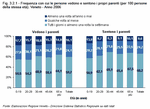 |
| Figure 3.2.2 |
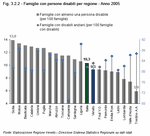 |
| Table 3.2.3 |
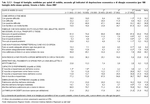 |
| Figure 3.2.3 |
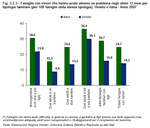 |
| Figure 3.2.4 |
 |
| Figure 3.2.5 |
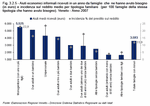 |
|
|













